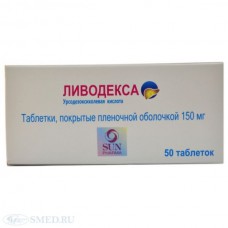Expiration date: 01/2026
The composition and form of issue
Levadex tablets, film-coated
1 tablet contains ursodeoxycholic acid 150 and 300 mg
packaging 50 or 100 PCs.
Pharmacological action
Livodexa - hepatoprotector. Also has choleretic, cholelitolitic, hypolipidemic, hypocholesterolemic and immunomodulatory effects. It stabilizes the membranes of hepatocytes and cholangiocytes has a direct cytoprotective effect. As a result of action of the drug on the gastrointestinal circulation of bile acids decreases the content of hydrophobic (potentially toxic) acids. By reducing cholesterol absorption in the intestine and other biochemical effects exerts a hypocholesterolemic effect. Suppresses cell death caused by toxic bile acids.
With high polar properties, ursodeoxycholic acid forms a non-toxic mixed micelles with non-polar (toxic) bile acids, which reduces the ability of gastric reluctate to damage cell membranes in biliary reflux-gastritis and reflux-esophagitis. In addition, ursodeoxycholic acid forms double molecules, to be included in the composition of cell membranes to stabilize them and make them impervious to the action of cytotoxic micelles. Reduces the saturation of bile with cholesterol due to inhibition of its absorption in the intestine and suppressing synthesis in the liver and decrease the secretion in the bile increases the solubility of cholesterol in bile, forming with it liquid crystals, reduces the lithogenic index of bile. The result is the dissolution of cholesterol gallstones (the result of the change in the ratio of cholesterol/bile acids in bile) and preventing formation of new stones (the result of reducing the amount of bile cholesterol). Induces choleras rich in bicarbonate, which leads to increased passage of bile and stimulates the excretion of toxic bile acids through the intestines.
Immunomodulatory effect is due to inhibition of expression of HLA-antigens (HLA - human leucocyte antigens - HIA antigens) on the membrane of hepatocytes and cholangiocytes, normalization of natural killer activity of lymphocytes. Significantly delays the progression of fibrosis in patients with primary biliary cirrhosis, cystic fibrosis and alcoholic steatohepatitis, reduces the risk of developing varicose veins of the esophagus.
Testimony
- primary biliary cirrhosis in the absence of signs of decompensation (symptomatic therapy),
- the dissolution of small and medium cholesterol stones in a functioning gall bladder
- biliary reflux-gastritis.
Contraindications
- roentgenologically (high in calcium) gall stones
- nonfunctioning gallbladder
- acute inflammatory diseases of the gall bladder, bile ducts and intestines,
- liver cirrhosis in the decompensation stage,
- severe hepatic and/or renal failure,
- pancreatitis,
- lactose intolerance, lactase deficiency or malabsorption of glucose-galactose
- pregnancy
- lactation,
- adults and children weighing up to 34 kilograms (for this dosage form),
- increased individual sensitivity to product components.
Application of pregnancy and breastfeeding
In pregnancy, the use of the drug is contraindicated Levadex. If necessary, the appointment of the drug during lactation should abandon breastfeeding.
Method of application and doses
The tablets are taken orally, in the evening, not liquid, squeezed small amounts of water.
For dissolution of cholesterol gall stones of average daily dose of Ursodeoxy is 10 mg/kg the Course of treatment is 6-12 months.
For the prevention of recurrent stone formation it is recommended that the drug for a few more months after dissolution of stones.
In biliary reflux-gastritis dose is 250 mg 1 time/day. The course of treatment - from 10-14 days to 6 months, if necessary - up to 2 years.
Symptomatic treatment of primary biliary cirrhosis: the average daily dose of 10-15 mg/kg.
Side effects
From the digestive system: the calcination of gallstones, increase in liver transaminases, diarrhea, nausea, abdominal pain, in the treatment of primary biliary cirrhosis can be observed transient decompensation of cirrhosis of the liver, going after drug withdrawal.
Special instructions
For the successful dissolution requires that the stones were pure cholesterol, no larger than 15-20 mm, the gallbladder stones filled no more than half full and bile passages fully retained its function.
In the appointment with the purpose of dissolving gallstones it is necessary to control liver transaminases and alkaline phosphatase, GGT, bilirubin concentration. While maintaining the high rate of the drug should be discontinued.
Cholecystography should be performed every 4 weeks during the first 3 months of treatment, and thereafter every 3 months. Monitoring the effectiveness of treatment performed every 6 months during the ultrasound examination during the first year of treatment. After full dissolution of stones is recommended to continue the application for at least 3 months, in order to facilitate the dissolution of the remnants of stones whose dimensions are too small to detect them.
If within 6-12 months after the start of therapy partial dissolution of stones did not happen, it is unlikely that treatment will be effective.
Detection during treatment revisualizing gallbladder is an indication that complete dissolution of stones did not happen, and treatment should be discontinued.
When calcification of gallstones, a violation of the contractility of the gall bladder or frequent episodes of biliary colic, treatment should be discontinued.
Drug interactions
You should not use the drug together with antacids containing aluminum or ion exchange resins, as these drugs can disrupt the absorption of ursodeoxycholic acid.
While the use of lipid-lowering drugs, estrogens, neomycin or progestin (oral contraceptives) increase the saturation of bile with cholesterol and may reduce the ability of ursodeoxycholic acid to dissolve cholesterol gall stones.
Levadex can increase the absorption of ciclosporin from the intestine, which requires the monitoring of the concentration of cyclosporine in the blood, and if necessary — correction of dosing regimen.
Storage conditions
The drug should be stored in a dry, dark, inaccessible to children place at temperature not exceeding 25°C.
Shelf life - 2 years.




